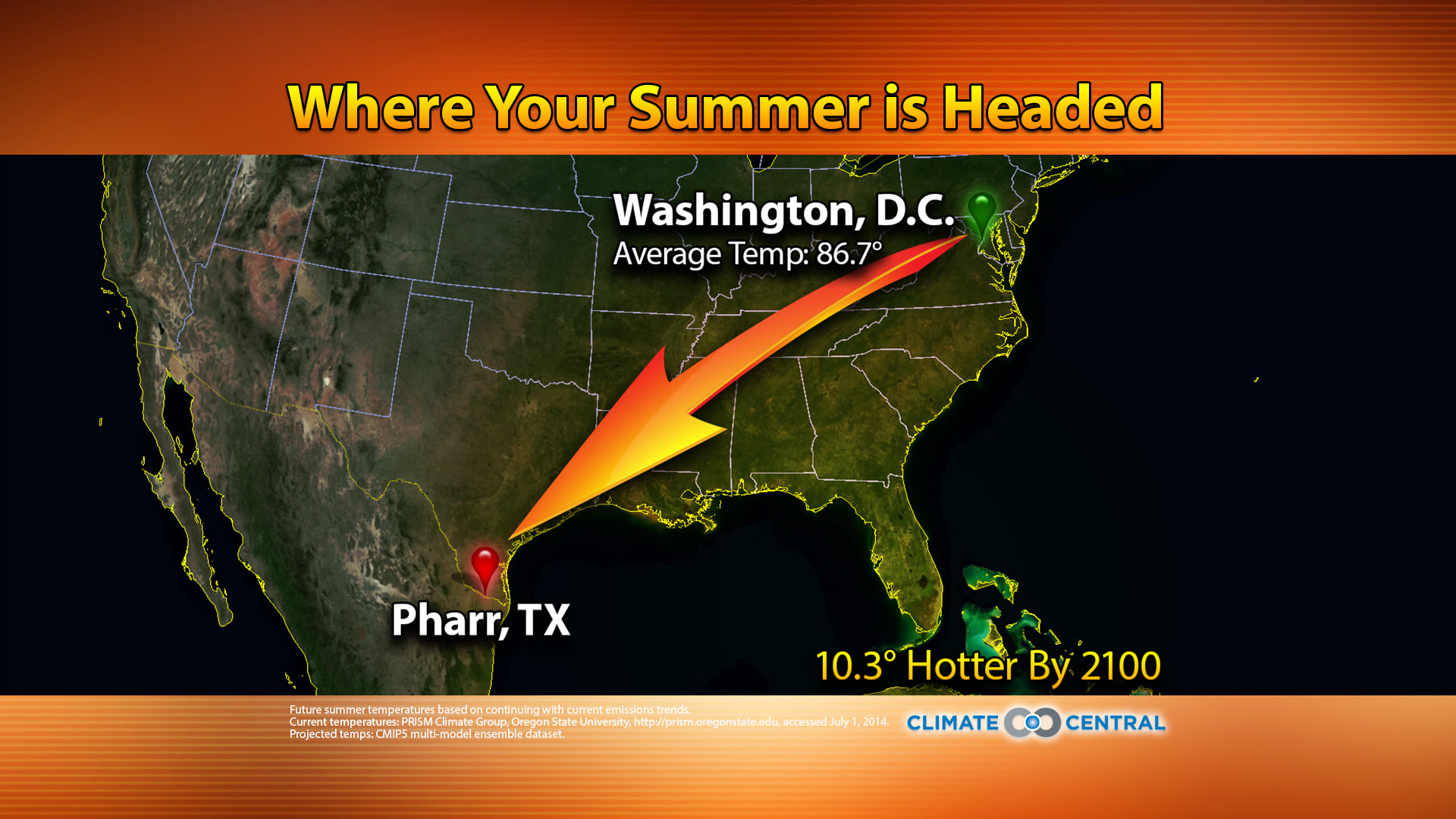Climate scientists know from many lines of evidence that if we don’t reduce emissions of heat-trapping greenhouse gases, the planet has no choice but to keep warming. They can even tell us with a good amount of confidence how much warmer it’s likely to get by the end of the century. But they’re always talking in averages, which don’t help most people understand what global warming will really feel like. In this week’s Climate Matters, we try to illustrate just that.
We’ve taken your city’s projected summer high temperatures for the end of this century, based on current emissions trends continuing unabated, and then showed which city in the U.S. — or elsewhere, if we can’t find one here — is experiencing those temperatures today. When you look at it that way, it’s clear how dramatic the changes will be.
As we approach 2100, for example, Chicago’s average summer high will be more than 11°F higher than it is now, making summers in the Windy City as hot as summers in Mesquite, Texas, today. Minneapolis will also feel the like Mesquite as its temperature will jump a whopping 11.8°F. Boston will experience a 9.3°F jump, making it as sweltering as North Miami Beach. Summers in Buffalo, with an 11.3°F temperature increase, are also going to feel like summers in Florida, this time more like Delray Beach. And Grand Junction, Colo., which will be 10.8°F higher, will be more akin to Laredo, Texas.
In fact, summers in most cities in the country are going to feel more like summers in Texas or Florida. And even in Texas, some of its cities will feel like they’ve moved elsewhere. Abilene will feel more like Casas Adobes, Ariz., and Laredo, with a projected summer average high of 108.7°F, will be so hot that the best comparison is half a world away in Abu Dhabi in the Persian Gulf. That’s not the only city that will feel more like living in the Middle East. Phoenix, with a projected average summer high of 113.6°F, will simmer like Kuwait City. And Las Vegas, at a projected 111.3°F, will be more like summering in Riyadh, Saudi Arabia.
It’s important to remember a couple of caveats about this analysis. First, we looked only at summer high temperatures. We didn’t address dewpoints or humidity, which also play into how uncomfortable a summer day feels. Second, these temperature projections assume we stay on the same greenhouse-gas emissions path that we are currently on. If we do find a way to make significant emissions cuts, the warming will not be as drastic.
Still, it’s an intriguing — and disturbing — exercise to see what summers in your city will feel like by the end of the century.
We have also included an online interactive “Future Summers” to be shared through social media or loaded to your station’s website. It includes summer temperature analyses for 1,001 U.S. cities.
DESCRIPTION OF ANALYSIS: Summer high temperatures (average of daily maximum temperatures for June, July, and August) were calculated with 1986-2005 data from PRISM Climate Group, Oregon State University, http://prism.oregonstate.edu, accessed 1 July 2014. Projected summer high temperatures were calculated for 1001 U.S. cities for the period 2081-2099, based on the RCP8.5 emissions scenario, which is the high emissions scenario used in the IPCCs 5th assessment report. This is essentially a continuation of our current emissions trends through the end of the century. The temperature change was calculated through that period using a downscaled multi-model ensemble approach (Downscaled CMIP5 Climate Projections archive at http://gdo-dcp.ucllnl.org/downscaled_cmip_projections/) and that number was added to the current temperature (from PRISM) to get the future temperature.
